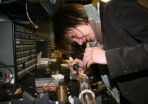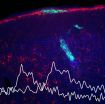Genetic predisposition to elevated LDL-C associated with narrowing of the aortic valve
2014-10-26
(Press-News.org) In an analysis that included approximately 35,000 participants, genetic predisposition to elevated low-density lipoprotein cholesterol (LDL-C) was associated with aortic valve calcium and narrowing of the aortic valve, findings that support a causal association between LDL-C and aortic valve disease, according to a study appearing in JAMA. The study is being released to coincide with its presentation at the Canadian Cardiovascular Congress.
Aortic valve disease remains the most common form of heart valve disease in Europe and North America and is the most common indication for valve replacement. Despite the heavy disease burden, no medical treatments are known to stop or slow disease progression. Plasma LDL-C has been associated with aortic stenosis (narrowing) in observational studies; however, randomized trials with cholesterol-lowering therapies in individuals with established valve disease have failed to demonstrate reduced disease progression. If LDL-C plays a causal role in the earlier stages of aortic valve disease, this could have important implications for prevention, according to background information on the article.
Because of the random allocation of genetic information that occurs at conception, genetic variation can be used as an effective tool to distinguish potentially causal from noncausal biomarkers. Termed "Mendelian randomization," this approach has been successfully applied to assess for causality of several biomarkers with various clinical end points. Using this approach, J. Gustav Smith, M.D., of Lund University, Lund, Sweden, and colleagues, evaluated whether weighted genetic risk scores (GRSs), a measure of the genetic predisposition to elevations in plasma lipids, were associated with aortic valve disease. The researchers included community-based cohorts participating in the CHARGE consortium (n = 6,942), including the Framingham Heart Study (cohort inception to last follow-up: 1971-2013; n = 1,295), Multi-Ethnic Study of Atherosclerosis (2000-2012; n = 2,527), Age Gene/Environment Study–Reykjavik (2000-2012; n = 3,120), and the Malmö Diet and Cancer Study (MDCS, 1991-2010; n = 28,461).
Aortic valve calcium was quantified by computed tomography; prevalent and new diagnoses of aortic stenosis and aortic valve replacement were identified by record linkage with nationwide registers on hospitalizations and causes of death.
The researchers found that in the subgroup of the MDCS where lipid fractions were measured (n = 5,269), baseline LDL-C, but not high-density lipoprotein cholesterol (HDL-C) or triglycerides (TG) levels, was significantly associated with new aortic stenosis. Also, the LDL-C GRS, but not HDL-C or TG GRS, was significantly associated with presence of aortic valve calcium in CHARGE and with new aortic stenosis in MDCS.
"Our findings link a genetically mediated increase in plasma LDL-C with early subclinical valve disease, as measured by aortic valve calcium, and incident clinical aortic stenosis, providing supportive evidence for a causal role of LDL-C in the development of aortic stenosis," the authors write. "These data suggest that, in addition to the established risks for myocardial infarction and other vascular diseases, increases in LDL-C are also associated with increased risk for aortic stenosis."
"Whether earlier intervention to reduce LDL-C could prevent aortic valve disease merits further investigation."
INFORMATION:
doi:10.1001/jama.2014.13959
Please see the article for additional information, including other authors, author contributions and affiliations, financial disclosures, funding and support, etc.
ELSE PRESS RELEASES FROM THIS DATE:
2014-10-26
Stanford, CA— Proteins are the machinery that accomplishes almost every task in every cell in every living organism. The instructions for how to build each protein are written into a cell's DNA. But once the proteins are constructed, they must be shipped off to the proper place to perform their jobs. New work from a team of scientists led by Carnegie's Munevver Aksoy and Arthur Grossman, describes a potentially new pathway for targeting newly manufactured proteins to the correct location. Their work is published by The Plant Cell.
The team's discovery concerns ...
2014-10-26
October 26, 2014, New York, NY – Ludwig Oxford researchers have discovered a key mechanism that governs how cells of the epithelia, the soft lining of inner body cavities, shift between a rigid, highly structured and immobile state and a flexible and motile form. Published in the current issue of Nature Cell Biology, their study shows that a tumor suppressor protein named ASPP2 functions as a molecular switch that controls this process and its reverse, both of which play a critical role in a number of biological phenomena, including wound healing, embryonic development ...
2014-10-26
PROVIDENCE, R.I. [Brown University] — Superconductors and magnetic fields do not usually get along. But a research team led by a Brown University physicist has produced new evidence for an exotic superconducting state, first predicted a half-century ago, that can indeed arise when a superconductor is exposed to a strong magnetic field.
"It took 50 years to show that this phenomenon indeed happens," said Vesna Mitrovic, associate professor of physics at Brown University, who led the work. "We have identified the microscopic nature of this exotic quantum state of ...
2014-10-26
Scientists have created cells with fluorescent dyes that change color in response to specific neurochemicals. By implanting these cells into living mammalian brains, they have shown how neurochemical signaling changes as a food reward drives learning, they report in Nature Methods online October 26.
These cells, called CNiFERs (pronounced "sniffers"), can detect small amounts of a neurotransmitter, either dopamine or norepinephrine, with fine resolution in both location and timing. Dopamine has long been of interest to neuroscientists for its role in learning, reward, ...
2014-10-26
Lasers – devices that deliver beams of highly organized light – are so deeply integrated into modern technology that their basic operations would seem well understood. CD players, medical diagnostics and military surveillance all depend on lasers.
Re-examining longstanding beliefs about the physics of these devices, Princeton engineers have now shown that carefully restricting the delivery of power to certain areas within a laser could boost its output by many orders of magnitude. The finding, published Oct. 26 in the journal Nature Photonics, could allow ...
2014-10-26
NEW YORK, NY (October 26, 2014)—Dietary cocoa flavanols—naturally occurring bioactives found in cocoa—reversed age-related memory decline in healthy older adults, according to a study led by Columbia University Medical Center (CUMC) scientists. The study, published today in the advance online issue of Nature Neuroscience, provides the first direct evidence that one component of age-related memory decline in humans is caused by changes in a specific region of the brain and that this form of memory decline can be improved by a dietary intervention.
As ...
2014-10-26
MOUNT WILSON, Calif.–Astronomers at Georgia State University's Center for High Angular Resolution Astronomy (CHARA) have observed the expanding thermonuclear fireball from a nova that erupted last year in the constellation Delphinus with unprecedented clarity.
The observations produced the first images of a nova during the early fireball stage and revealed how the structure of the ejected material evolves as the gas expands and cools. It appears the expansion is more complicated than simple models previously predicted, scientists said. The results of these observations, ...
2014-10-26
BOSTON –– Scientists say they have identified in about 20 percent of colorectal and endometrial cancers a genetic mutation that had been overlooked in recent large, comprehensive gene searches. With this discovery, the altered gene, called RNF43, now ranks as one of the most common mutations in the two cancer types.
Reporting in the October 26, 2014 edition of Nature Genetics, investigators from Dana-Farber Cancer Institute and the Broad Institute of MIT and Harvard said the mutated gene helps control an important cell-signaling pathway, Wnt, that has been ...
2014-10-26
Why do we remember some things and not others? In a unique imaging study, two Northwestern University researchers have discovered how neurons in the brain might allow some experiences to be remembered while others are forgotten. It turns out, if you want to remember something about your environment, you better involve your dendrites.
Using a high-resolution, one-of-a-kind microscope, Daniel A. Dombeck and Mark E. J. Sheffield peered into the brain of a living animal and saw exactly what was happening in individual neurons called place cells as the animal navigated a virtual ...
2014-10-26
Digoxin, a medication used in the treatment of heart failure, may be adaptable for the treatment of amyotrophic lateral sclerosis (ALS), a progressive, paralyzing disease, suggests new research at Washington University School of Medicine in St. Louis.
ALS, also known as Lou Gehrig's disease, destroys the nerve cells that control muscles. This leads to loss of mobility, difficulty breathing and swallowing and eventually death. Riluzole, the sole medication approved to treat the disease, has only marginal benefits in patients.
But in a new study conducted in cell cultures ...
LAST 30 PRESS RELEASES:
[Press-News.org] Genetic predisposition to elevated LDL-C associated with narrowing of the aortic valve





